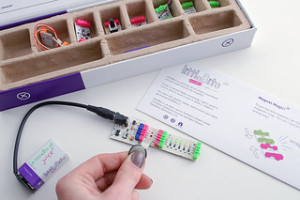Students introduced to circuitry at #MakeElon workshop
 What do chickens, fire trucks, and alarm clocks have in common? They are all among the projects created during a #MakeElon workshop featuring Legos and LittleBits electronics. During the workshop, Kenneth Wilson, Coordinator of Interactive Projects at Elon, guided a group of faculty and entrepreneurship students through the basics of circuitry and electronic projects before releasing the power of LittleBits into their hands for experimentation. Read on to see the creations and learn about the endless uses of LittleBits electronics.
What do chickens, fire trucks, and alarm clocks have in common? They are all among the projects created during a #MakeElon workshop featuring Legos and LittleBits electronics. During the workshop, Kenneth Wilson, Coordinator of Interactive Projects at Elon, guided a group of faculty and entrepreneurship students through the basics of circuitry and electronic projects before releasing the power of LittleBits into their hands for experimentation. Read on to see the creations and learn about the endless uses of LittleBits electronics.
The basics of circuitry
Faculty, staff, and students from Sean McMahon’s Entrepreneurial Finance course (ENT 340) listened as Wilson explained electronic concepts such as circuits, voltage, ohms and amps. Makers learned that at the very basic level, a circuit is a completed and closed path around which a electric current can flow. Circuits power variety of electronic outputs, including the LED (light-emitting diode) lights that power the computer or mobile screen on which you’re reading this post. As Wilson demonstrated, these electrical concepts form the basis of LittleBits, the small electrical units students would later use to build their own projects.
LittleBits and project-building
 LittleBits provide a simple, user-friendly way to add electronics to projects. Created with the mission of placing the power of electronics in the hands of everyone, LittleBits are minuscule electrical units that can create complex circuits to make, well, anything.
LittleBits provide a simple, user-friendly way to add electronics to projects. Created with the mission of placing the power of electronics in the hands of everyone, LittleBits are minuscule electrical units that can create complex circuits to make, well, anything.
LittleBits units are divided up into four categories, organized by color. Blue bits power the circuit, pink bits control the power (think on/off switch), orange bits extend the circuit, and green bits provide electrical output in the form of sound, light, or motion. Because the bits are magnetic, assembly and disassembly is extremely user-friendly and requires only minimal knowledge of circuits.
LittleBits also offers a BitLab where advanced makers can create and submit their projects for production and distribution. To see examples of some mind-blowing LittleBits projects, check out their lab.
Making with LittleBits
After their brief circuitry lesson, students and makers had the chance to create original electronic projects using LittleBits and Lego blocks. Dr. McMahon’s students had extra incentive to engage their entrepreneurial spirit with extra class credit being offered to the most creative projects.
After making for forty-five minutes in small groups, students presented their final projects, which included a firetruck, car, snow-blowing machine, chicken, and two lighthouses, among other creations. In addition to Lego blocks, many of the creations featured interactive electrical components such as fans, flash lights and sirens.
In the end, makers of the top projects were awarded bonus points for creativity, and left April’s first #MakeElon workshop knowing more about the circuitry that powers so much of our modern, electronic world. To see more photos and videos of the projects in action, visit the event’s Facebook page.
LittleBits were only the latest technology to be featured at a #MakeElon workshop. #MakeElon is a community of students, faculty and staff interested in creating a makerspace on campus – an environment that supports creativity and building. If you’re interested in getting involved with making on campus, check out the list of upcoming maker-inspired events and workshops.
Photo of LittleBits circuit via Flickr user Adafruit Industries / CC BY-NC-SA 2.0
 Follow
Follow


